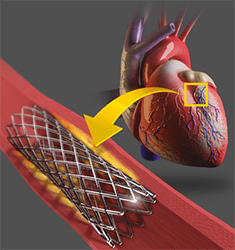
A stent is a tiny, metal or plastic mesh tube that is placed permanently inside a blood vessel to relieve an obstruction. The procedure of inserting and placing the stent within your arterial wall through a small tube (catheter) is known as stenting.
When and Why do You Need Coronary Stenting?
- You may need stenting when:
- Artery blockage is severe, and your heart condition is serious
- Medications or lifestyle changes have not improved your condition
- You have experienced a heart attack
Stenting helps keep the arteries open and decrease the chances of narrowing or blocking again.
Preparing You for the Procedure
Prior to the procedure, your doctor will evaluate your medical history and perform a detailed physical examination. A chest X-ray, an electrocardiogram (to record heartbeat) and necessary blood tests may be carried out. Subsequently, an imaging test (coronary angiogram) to locate the blockages is also performed.
Your doctor will instruct you to stop taking certain medications such as for diabetes before the procedure.
The Procedure
Stenting
Your doctor will choose the type of stent depending on the artery size and blockage. Following the angioplasty, your doctor will:
- Mount a collapsed stent on an inflated balloon at the tip of the catheter.
- Direct and move the stent over the guidewire through the artery to the blockage.
- Ensure the balloon opens the stent against the walls of the blocked artery.
- Make the stent expand at the blockage and lock in position inside the artery.
- Once the stent is in place, remove the balloon and the catheter from the artery.
The whole procedure may take several hours, depending on the number of blockages and other complications. Your doctor may have to repeat the procedure at each blockage if you have several blockages.
Risks Associated with the Procedure
Coronary stenting carries a few risks. The most common of them include:
- Blood clots: These may be formed within the stents, close the artery and cause a heart attack
- Bleeding: You may have bleeding at the spot where the catheter was inserted
- Heart attack: You may suffer from a heart attack during the procedure, though rarely
- Coronary artery damage: Your coronary artery may get torn or ruptured
- Kidney problems: The contrast dye used during the procedure can damage your kidneys
- Stroke: A stroke can occur in rare cases even after blood thinners are used
- Abnormal heart rhythms: Your heart may beat too quickly or too slowly
After Care and Recovery
Post procedure, you may need medications and additional care as prescribed by your doctor. It may take you a week before you are able to return to your normal routine.
Benefits of Coronary Stenting
This procedure clears blocked arteries and significantly increases the blood flow to your heart. Consequently, it reduces the amount of damage to your heart and keeps your heart healthy.
